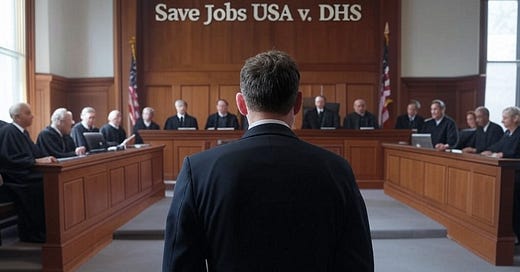Save Jobs USA v. DHS - SCOTUS' Time to Shine
It's the Role of Congress, Not the Administrative State, to Legislate on Immigration
Things are coming to a head as the "Save Jobs USA v. DHS" case winds its way to the Supreme Court. The case concerns the Department of Homeland Security's (DHS) authority to grant work authorization to spouses of H-1B visa holders in the country on H-4 visas. In 2015, Save Jobs USA, an association representing American tech workers (notably former employees of Southern California Edison who were replaced by H-1B workers), challenged the authority of President Obama’s DHS to implement such a rule change and argued it had exceeded its authority in doing so.
It’s been a long road, but many are confident that if the case gets before SCOTUS, Save Jobs USA will prevail.
Key arguments for the Supreme Court ruling in favor of Save Jobs USA include:
Statutory authority questions: The plaintiffs argue that DHS exceeded its statutory authority by creating the H-4 EAD (Employment Authorization Document) program, as the Immigration and Nationality Act doesn't explicitly authorize work permits for H-4 visa holders.
Economic impact concerns: Save Jobs USA represents American technology workers who claim they face unfair competition and potential job displacement from H-4 visa holders entering the job market.
Administrative Procedure Act considerations: There are arguments that DHS didn't adequately justify the rule or consider its economic impact on American workers as required by the APA.
Separation of powers: Some argue that such significant immigration policy decisions should be made by Congress rather than executive agencies.
The Major Questions Doctrine: A principle of statutory interpretation in U.S. administrative law that limits federal agencies' authority to decide issues of major economic and political significance without clear congressional authorization.
It has been a long and winding road through the lower courts. A summary judgement at the district court level in 2016, ruled DHS had broad authority to make such changes and that Save Jobs USA did not have standing because they could not demonstrate concrete “injury-in-fact.” Save Jobs USA appealed to a higher court.
First Appeal
In 2019, the D.C. Circuit Court reversed the lower court’s standing decision citing “competitor standing,” which recognizes that increased competition in a market can constitute an injury-in-fact. The court found that Save Jobs USA had sufficiently demonstrated that the H-4 Rule would likely increase competition for its members in the tech job market. The case was remanded to the district court for a merits determination, as the lower court had not fully addressed the legality of the rule.
Unfortunately, in 2023, it was déjà vu at the district court where the same judge once more ruled in favor of DHS.
Second Appeal
In the same year, Save Jobs USA appealed again invoking the “major questions doctrine” and agency overreach. But the Circuit court dismissed arguments invoking the major questions doctrine and upheld the H-4 Rule as a lawful exercise of DHS authority. And now it is off to SCOTUS.
The Crisis
The Attorney for Save Jobs USA, John Miano, stated “SCOTUS has punted for too long on the issue of alien employment to the point where it has now reached a crisis stage.” To better understand the crisis, one must understand the kind of numbers we are dealing with.
Between Fiscal Year 2015 and Fiscal Year 2024, there have been 556,417 H-4 visa work permit approvals.
The Institute for Sound Public Policy’s estimate for the total number of H-4 EAD holders in fiscal year 2024 is 150,000.
Two-thirds of H-4 EAD visa holders work in computer or IT jobs and 97% are Indian nationals.
It allows IT outsourcing firms to get two workers for the price of one if they sponsor one green card.
There are no wage protections, meaning employers can pay any wage and H-4 EAD visa holders can work anywhere.
According to the Bureau of Labor and Statistics, 21 million prime-age adults (25-54) are not working; 18.6 million are not seeking work and 2.8 million are unemployed. When the H-1B visa was created in 1990, the labor force participation rate was 66.5%. Today, it is 62.6%.
We have an employment crisis in this country. The priority should not be finding creative ways to issue more work permits to foreigners, it should be to find gainful employment for our citizens.
It’s not just H-4 EAD. STEM OPT and programs such as Humanitarian Parole are being used extensively to increase the supply of labor by bringing in armies of foreign workers. Saves Jobs USA is an opportunity for SCOTUS to disallow the neoliberals and globalists from crafting de facto immigration laws that are rubber stamped by government agencies and prevent the American worker from being sidelined. It's time for SCOTUS to stop fiddling while the immigration system burns and to finally answer the question of whether DHS has the power to create alien work programs on its own.






